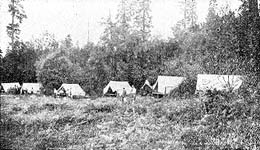In June 1905, the Young Men's Christian Association establishes a residential camp near Columbia City to give working-class youth a chance to enjoy summer evenings and weekends out of doors. "Camp Hiu Skookum" -- also called the Lakeside Boarding Camp -- is located on Andrews Bay on Lake Washington, opposite what was then called Bailey Peninsula (today Seward Park), a 20-minute walk from the Columbia City stop on the Seattle, Renton and Southern Railway.
In contrast to most YMCA camps, which were aimed at middle-class boys, Hiu Skookum served young working men, ages 16 to 20, who could not leave their jobs during the day. The proximity of the streetcar line made the camp easily accessible from all parts of Seattle.
Conditions were rustic, as they were in most YMCA camps of the era. The campers slept in large canvas tents on raised platforms. Wire mattresses were supplied, but the campers had to bring their own bedding. Breakfast and dinner were served in an open-air dining room. The fee was $5 a week (rising to $5.75 by 1916), considerably less than the cost of room and board elsewhere in the city. Canoes and rowboats could be rented for a nominal charge. Other activities included sports, games, and "straightforward manly Bible Study Groups" ("Vacation Plans for Men").
The camp operated throughout the summer months until 1917, attracting an average of 35 campers each season.

